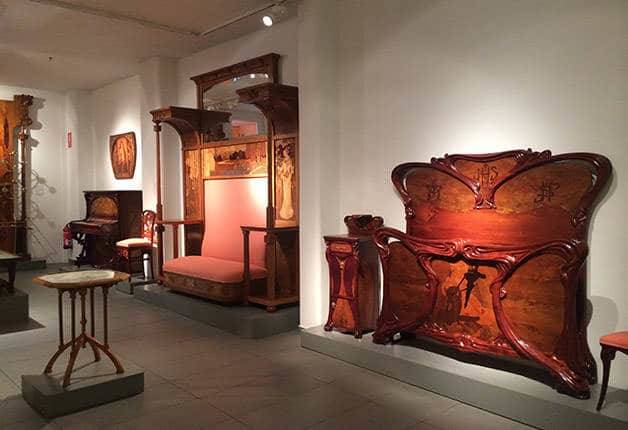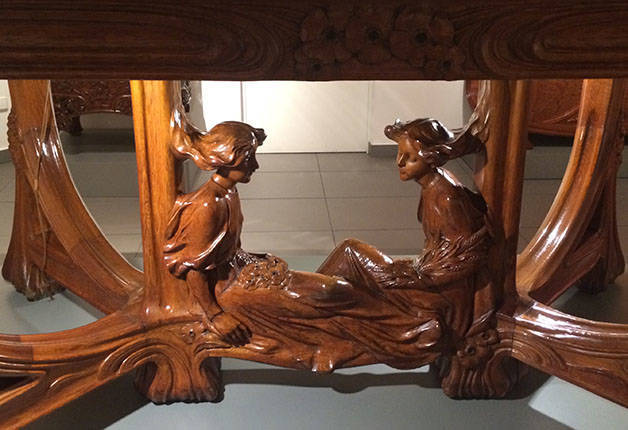Museu del Modernisme Català: a broader vision of art nouveau

Barcelona’s Art Nouveau buildings are so famous that modernism is sometimes seen as a purely architectural phenomenon. The reality is much more complex! Visit the Museu del Modernisme Català to discover the true richness of this artistic movement.
Art Nouveau in Catalonia
From an artistic movement to the construction of an identity
The Art Nouveau movement, which aimed to break away from the confines of classicism, was extremely influential in late-19th Century Europe. It took on a particuarly important role in Spain, most significantly in Catalonia.
More than a smiple fashion, Catalan Art Nouveau (or Modernism) resulted in urban, social and political redevelopment in Barcelona and Catalonia as a whole.
The local authorities adopted it as an official style, commissioning huge modernist edifices (such as the Palau de la Música Catalana and the Hospital de Sant Pau). The Art Nouveau style was adopted for the design of streetlights and of public benches. Its influence extended to religious buildings (Sagrada Familia), industrial complexes (Colonia Güell), scientific establishments (the Fabre Observatory) and more.
The many faces of modernism
Barcelona and Catalonia were the birthplace of an important Art Nouveau movement which spread its influence across the city, starting with the first Universal Exhibition in Barcelona in 1888.
- Modernism took on the status of a national art, and has become one of Barcelona’s main attractions, with Gaudí as the star of the show.
If you’ve already been to some of Barelona’s “star” modernist attractions (Casa Batlló, Casa Milà, Casa Amatller etc.), you may not see the point of visiting the museum as well – it’s probably not going to be top of your list if you’re only in the city for a few days.
If you have the time, though, and if you love art nouveau, it’s well worth a visit. The museum will give you a fresh, new perspective on modernism through its collections of paintings, sculptures and decorative objects.
The Museu del Modernisme Català
Opened in 2010, the Museu del Modernisme Català is one of a kind. Founded by a passionate couple of antiques specialists, it takes visitors on a journey through the different areas of the artistic movement (furniture, painting, sculpture and glasswork).The building
The Museu del Modernisme Català is housed, appropriately, in an Art Nouveau building. Just a stone’s throw from the Rambla Catalunya and the Passeig de Gràcia, it is situated in Barcelona’s modernist heartland.
The building was originally home to the textile retail company Fabra i Coats. It was converted specially to house the museum’s collections, but a number of important architectural features were conserved, including the vaults and the floors.
The collections
Although the museum isn’t huge, it houses very varied collections, giving a good impression of the breadth and diversity of the art nouveau movement.
- Furniture: pieces of all shapes and sizes are displayed in three rooms (Busquets, Homar and Gaudí), each presenting works by the 3 artists. You’ll be able to admire the rich decoration and fine detailing on each item much more easily than at Casa Batlló or La Pedrera, where you may find your view blocked by the crowds.
- Painting: the museum’s painting collection highlights the aspects of social renewal found in the modernist movement. The art nouveau style of painting is less “uniform” than certain other styles, such as impressionism or cubism, but focuses on reflecting the social changes of the late 19th Century. Featured artists include Ramon Casas, an iconic modernist painter.
- Sculpture: the favourite themes of modernist sculptors were women and nature. Their works were often based on careful anatomical study, and made use of new techniques developed in France by Auguste Rodin.
- Decorative arts: one special feature of the modernist movement is the number of different ways in which it was expressed. Craftsmen created innovative designs, which they then produced using techniques dating back to the middle ages. The “minor arts”, such as metalwork, glasswork, ceramics and jewellery, were thus elevated to the status of arts in their own right. The Museu del Modernisme contains a number of excellent examples.

Useful information
- All explanations are available in English.
Opening times
- Tuesday – Saturday: 10.30am – 7pm
- Sunday and public holidays: 10.30am – 2pm
- Closed 1st and 6th January, 1st May and 25th and 26th December
Price
- Full price: €10
- Top tip: book using this link to get €1.50 off the cost of full-price tickets (bringing the price down to €8.50).
- Concessions: €7 (under-25s, over-65s)
- Child: €5 (6-16)
- Free for under 6s


